
The Spanish dancer, scientific name Hexabranchus sanguineus, is a dorid nudibranch, a very large and colorful sea slug, a marine gastropod mollusk in the family Hexabranchidae.The taxonomy of the genus Hexabranchus has been controversial but a thorough molecular and morphological study published in 2023 showed that the name H. sanguineus was being used for at least 5 distinct species.
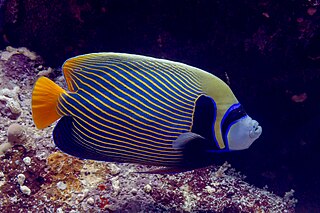
The emperor angelfish is a species of marine angelfish. It is a reef-associated fish, native to the Indian and Pacific Oceans, from the Red Sea to Hawaii and the Austral Islands. This species is generally associated with stable populations and faces no major threats of extinction. It is a favorite of photographers, artists, and aquarists because of its unique, brilliant pattern of coloration.
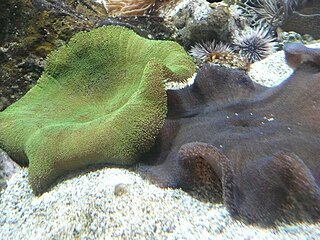
Stichodactyla haddoni, commonly known as Haddon's sea anemone, is a species of sea anemone belonging to the family Stichodactylidae. It is found in the Indo-Pacific area.

Thor amboinensis, commonly known as the squat shrimp or sexy shrimp, is a species of shrimp found across the Indo-West Pacific and in parts of the Atlantic Ocean. It lives symbiotically on corals, sea anemones and other marine invertebrates in shallow reef communities.

Ancylomenes magnificus, also known as the magnificent anemone shrimp, is a species of cleaner shrimp common to the Western Pacific Ocean at depths of 3–29 metres (10–95 ft). They are commonly found on stony coral, Catalaphyllia and the sea anemone, Dofleinia armata.

Hypselodoris tryoni is a species of sea slug, a dorid nudibranch, a marine gastropod mollusk in the genus Chromodorididae.
Periclimenes dardanicola is a species of shrimp found in the western Pacific Ocean. It lives in association with sea anemones that live on the gastropod shells carried by hermit crabs. It was first named by Alexander J. Bruce and Junji Okuno in 2006. It is mainly white, and grows up to a carapace length of 4 mm (0.16 in).
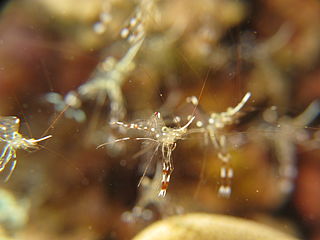
Urocaridella antonbruunii, common names clear cleaner shrimp or red-white cleaner shrimp, is a species of shrimp belonging to the family Palaemonidae. It was described by A. J. Bruce in 1967. It is one of the species that are known as cleaner shrimps.

Bohadschia argus, the leopard sea cucumber, leopardfish, or tigerfish, is a species of marine invertebrate in the family Holothuriidae.

Asthenosoma varium is a sea urchin. Growing up to 25 cm (10 in) in diameter, it lives on sand and rubble sea bottoms in the Indo-Pacific, from the Red Sea to Australia and Southern Japan. Its venom tipped spines, with distinctive globular swellings below the tip, can inflict a painful sting if handled; the pain lasts as long as several hours. This capacity, perhaps coupled with its reddish-brown colour, has given it the common name fire urchin; other commonly used names are Pacific fire urchin, elusive sea urchin, variable fire urchin, and electric sea urchin.

Periclimenes brevicarpalis, the glass anemone shrimp or peacock-tail anemone shrimp, is a species of shrimp belonging to the family Palaemonidae.

Ancylomenes venustus, also known as the graceful anemone shrimp, is a species of shrimp which belongs to the family of the Palaemonidae. This species is found in the tropical waters from the centre of the Indo-Pacific biogeographical area. A. venustus lives in association with scleractinians and actiniarians and is a cleaner shrimp.
Cuapetes lacertae, previously known as Periclimenes lacertae, is a species of shrimp belonging to the family Palaemonidae. Its name is due to the fact the first specimen was collected from Lizard Island: lacerta being Latin for "lizard".

Ancylomenes holthuisi is a species of marine shrimp in the family Palaemonidae. It was first described in 1969 by A.J. Bruce as Periclimenes holthuisi.
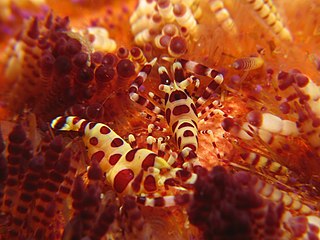
Periclimenes colemani is a species of saltwater shrimp found in the Indo-Pacific Ocean that was first described in 1975 by Alexander James Bruce.
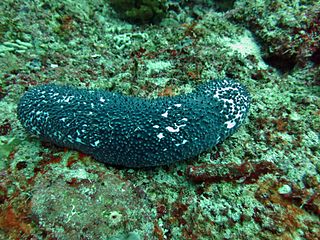
Actinopyga caerulea, the blue sea cucumber, is a species of sea cucumber in the family Holothuriidae. It is native to the tropical Western Indo-Pacific region and is harvested for food.

Periclimenes, commonly known as glass shrimp or cleaner shrimp, is a commensal and often symbiotic genus of semi-transparent shrimp within the family Palaemonidae. Species of this large genus feature a wide variety of coloration and patterns, widespread distribution throughout much of the world's tropical oceans, and are often sought out for aquarium trade.

Zenopontonia rex, the emperor shrimp or imperial shrimp, is a species of shrimp in the family Palaemonidae. It is found in shallow water in the tropical Indo-Pacific region. It lives in association with a sea cucumber, a nudibranch or other large mollusc, often changing its colour to match that of its host.

Zenopontonia is a genus of shrimp within the family Palaemonidae.
Mesopontonia gorgoniophila is a species of shrimp in the family Palaemonidae that was first described in 1967 by Alexander James Bruce. The specific name, gorgoniophila, describes the species as being a lover of gorgonians, given because it is found amongst gorgonian corals.



















